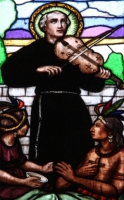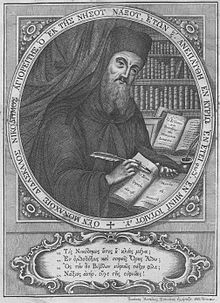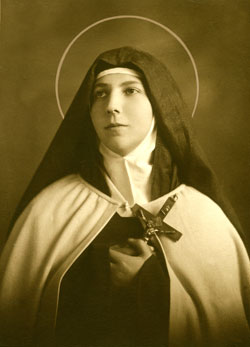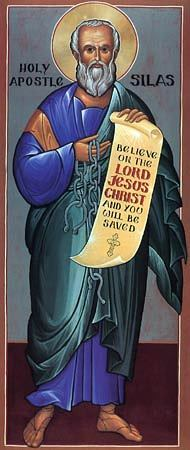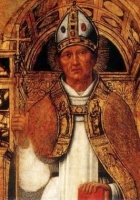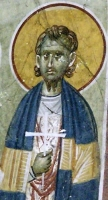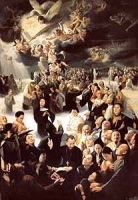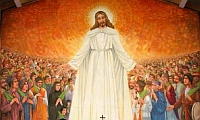St. Procopius of Sázava
Born c. 970
Chotouň, Bohemia
Died 25 March 1053
Sázava, Bohemia
Venerated in Catholic Church
Eastern Orthodox Church
Canonized 2 June 1204 by Pope Innocent III[2] or by a liturgical elevation and translation of his body to the altar in Sázava[1]
Feast 14 July (Roman Catholic)
16 September (Eastern Orthodox)
Attributes devil ploughing before him; depicted as an abbot with a book and whip, devil at his feet; with a stag (or hind) near him; with Saints Adalbert, Ludmila, and Vitus; hermit with a skull and a girdle of leaves
Patronage Bohemia
Basilian abbot, founder, and hermit. A native of Bohemia, he studied at Prague before receiving ordination and becoming a canon of the Basilians. In later years he devoted himself to the life of a hermit and then became an abbot founder of Sazaba Abbey, Prague. He was canonized in 1804.
Saint Procopius of Sázava (Latin: Procopius Sazavensis, Czech: Prokop Sázavský; died 25 March 1053) was a canon and hermit, canonized as a saint of the Catholic church in 1204.
Life
Little about his life is known with certainty. According to hagiographical tradition, he was born in 970, in a Central Bohemian village of Chotouň near Kouřim. He studied in Prague and was ordained there.
He was married and had a son, called Jimram (Emmeram), but later entered the Benedictine order, presumably at Břevnov Monastery, and eventually retired to the wilderness as a hermit, living in a cave on the banks of Sázava River, where over time he attracted a group of fellow hermits. The community of hermits was incorporated as a Benedictine monastery by the duke of Bohemia in 1032/3, now known as Sázava Monastery, or St Procopius Monastery, where he served as the first abbot for the span of twenty years until his death.
Veneration
Local veneration of Procopius as a saint is recorded for the 12th century when the first biography Vita minor has been written. He was canonized in 1204; however, there is still much debate on how his canonization was performed. It is stated that Pope Innocent III canonized him in 1204[2][5] or that during a liturgical elevation and translation of his body to the altar in Sázava his canonization took place. This was at that time the equivalent to canonization[1]
After his canonization, he became greatly venerated throughout Bohemia, to the point of his being considered the national saint of the Kingdom of Bohemia. His life and wonders were described by the Vita antiqua from the second half of the 13th century, and Vita maior from the 14th century. His remains were transferred to All Saints Church in Prague Castle in 1588.
The Cyrillic portion of the Reims Gospel manuscript (since 1554 kept in Reims, France) were attributed to Procopius in the 14th century, and Charles IV commissioned an extension of the manuscript in Glagolitic script.
Sázava Monastery had been destroyed in the Hussite Wars, but the church was re-established in the 17th century, as well as the monastery buildings changed in a castle. The Baroque-era frescos "The Meeting of Hermit Procopius with Prince Oldřich" and "Abbot Procopius Giving Alms" besides other frescos depicting scenes the saint's life and the history of the monastery, were discovered there (under layers of 19th-century paint) in the 2000s.
Hugo Fabricius, a monk at Sázava, wrote a new life of St. Procopius in the 18th century, Požehnaná Památka Welikého Swěta Diwotworce Swatýho Prokopa ("The Blessed Legacy of the Great Miracle Worker of the World, St. Procopius").
Numerous churches in Bohemia are dedicated to him, and many Baroque-era statues and paintings of the saint are extant. Among these is the early 18th century Procopius statue on Charles Bridge by Ferdinand Brokoff. Modern retellings of the saint's life were published by Czech poets Jaroslav Vrchlický and Vítězslav Nezval.
The "Cave of St. Procopius", the supposed site of his original hermitage, was discovered by Method Klement OSB in the 1940s.
On 9 March 2017, by the decision of the Holy Synod of the Russian Orthodox Church, the name of "Venerable Procopius, Abbot of Sázava" was added to the Menologium of the Russian Orthodox Church
Saint Camillus of Lellis
புனிதர் கமில்லஸ் டி லெல்லிஸ்
குரு/ சபை நிறுவனர்:
பிறப்பு: மே 25, 1550
புச்சியானிகோ, சீட்டி, நேப்பிள்ஸ் அரசு
இறப்பு: ஜூலை 14, 1614 (வயது 64)
ரோம், திருத்தந்தையர் மாநிலங்கள்
ஏற்கும் சமயம்:
ரோமன் கத்தோலிக்க திருச்சபை
அருளாளர் பட்டம்: கி.பி. 1742
திருத்தந்தை பதினான்காம் பெனடிக்ட்
புனிதர் பட்டம்: கி.பி. 1746
திருத்தந்தை பதினான்காம் பெனடிக்ட்
முக்கிய திருத்தலம்:
புனித மரியா மடலேனா தேவாலயம், இத்தாலி
பாதுகாவல்:
நோயாளிகள், மருத்துவர்கள், செவிலியர்கள், மருத்துவமனைகள்
நினைவுத் திருநாள்: ஜூலை 14
புனிதர் கமில்லஸ் டி லெல்லிஸ், ஒரு இத்தாலிய குருவும், நோயாளிகளின் சேவைகளுக்காக அர்ப்பணிக்கப்பட்ட ஒரு சபையின் நிறுவனரும் ஆவார்.
கமில்லஸ், கி.பி. 1550ம் ஆண்டு, மே மாதம், 25ம் நாளன்று, தற்போதைய “அப்ரஸ்ஸோ” (Abruzzo) (அன்றைய “நேப்பில்ஸ்” அரசின் (Kingdom of Naples) கீழிருந்த) பிறந்தார். இவர் பிறக்கும்போது, இவரது தாயார் “கமில்லாவுக்கு” (Camilla Compelli de Laureto) ஏறத்தாழ ஐம்பது வயது. இவரது தந்தை “நெப்போலிட்டன்” மற்றும் ஃபிரெஞ்ச்” அரச இராணுவங்களில் (Neapolitan and French Royal Armies) அதிகாரியாக பணியாற்றினார். கமில்லஸ் தந்தையின் கோப குணங்களைக் கொண்டு வளர்ந்தார். வயதான தாயாரால் இவரைக் கட்டுப்படுத்த இயலவில்லை. இவருக்கு பன்னிரண்டு வயதாகையில் தாயார் மரித்துப் போனார்.
தாயை இழந்த கமில்லஸ் யாரும் கவனிப்பாரற்று, ஆதரவற்றிருந்தார். பதினாறு வயதிலேயே “வெனீஷியன்” (Venetian Army) இராணுவத்தில் சேர்ந்தார். துருக்கி (Turks) நாட்டுக்கெதிரான போரிலும் பங்குகொண்டார். பத்து வருடங்களுக்கும் மேல் இராணுவத்தில் பணியாற்றிய பின்னர், அவர் பணி புரிந்த இராணுவ படைப் பிரிவு கலைக்கப்பட்டது. வேறு வழியற்ற கமில்லஸ், “மன்ஃபிரடோனியா” (Manfredonia) எனுமிடத்திலுள்ள கபுச்சின் (Capuchin Friary) துறவற மடத்தில் கூலி வேலை செய்யத் தொடங்கினார்.
கமில்லஸ் இராணுவத்திலிருந்தபோது காலில் அடி பட்டு காயம் ஏற்பட்டிருந்தது. அது ஆறாமல் கடுமையாக பாதிக்கப்பட்டார். கமில்லஸிடம் ஆக்ரோஷ குணங்களுடன் சூதாடும் பழக்கமுமிருந்தது. இவரை கண்காணித்து வந்த துறவற மடத்தின் பாதுகாவலர், இவரை திருத்தி இவரிடமுள்ள நற்குணங்களை வெளிக்கொணர தொடர்ந்து முயற்சித்தார். இறுதியில், துறவியின் அறிவுரை அவரது இதயத்தை ஊடுருவியது. அத்துடன், கி.பி. 1575ம் ஆண்டு இவர் கத்தோலிக்கராக மனம் மாறினார். கபுச்சின் (Capuchin) சபையின் புகுமுக துறவியாக (Novitiate) இணைந்தார். எனினும் அவரது காலிலிருந்த புண் அவருக்கு தொடர்ந்து வேதனை அளித்தது. அது இனி குணமாக்க இயலாது என்று மருத்துவர்கள் கைவிரித்து விட்டனர். இதன் காரணமாக அவருக்கு கபுச்சின் சபையில் அனுமதி மறுக்கப்பட்டது.
பின்னர் ரோம் (Rome) பயணமான கமில்லஸ், அங்கே, “குணமாக்க இயலாது” என்று கைவிடப்பட்ட நோயாளிகளுக்கு மருத்துவம் செய்யும், “சேன் கியகோமோ மருத்துவமனையில்” (San Giacomo Hospital) இணைந்தார். (இம்மருத்துவமனை, புனிதர் ஜேம்ஸ் மருத்துவமனை சபையால் (Hospitaller Knights of St. James) நிறுவப்பட்டது. அங்கே, தாமும் ஒரு நோயாளிகளைப் கவனிப்பவராக (Caregiver) மாறிய கமில்லஸ், பின்னாளில் அதே மருத்துவமனையின் கண்காணிப்பாளராக (Superintendent) உயர்ந்தார். இதற்கிடையே துறவு வாழ்வு வாழ்ந்த இவர், செபம் – தவம் ஆகியவற்றையும் தீவிரமாக பின்பற்றினார். மயிரிழைகளாலான மேலாடையையே அணிந்தார். உள்ளூரில் பிரபலமான குருவான அருட்தந்தை (பின்னர் புனிதராக அருட்பொழிவு செய்யப்பட்டவர்) “ஃபிலிப் நேரி” (Philip Neri) அவர்களை தமது ஒப்புரவாளராகவும் (Confessor), ஆன்மீக வழிகாட்டியாகவும் (Spiritual Director) ஏற்றுக்கொண்டார்.
தமது மருத்துவமனையின் பணியாளர்கள் நோயாளிகளை சரியாக கவனிப்பதில்லை என்பதனை கண்ட லெல்லிஸ், நோயாளிகளின் சேவையில் தமது பக்தி விசுவாசத்தை வெளிப்படுத்த வெளியிலிருந்து பயபக்தியுடைய ஆண்கள் குழுக்களை அழைத்து வந்தார். இறுதியில், இந்த காரணத்துக்காக ஒரு மத சபையை தொடங்க எண்ணினார். இதற்கான அங்கீகாரத்தை திருச்சபையிடமிருந்து வேண்டினார். “ஃபிலிப் நேரி” (Philip Neri) இப்பெருமுயற்சியை அங்கீகரித்தார். ஒரு பணக்கார கொடை வள்ளல் லெல்லிஸின் இறையியல் கல்விக்கான செலவுகளை கொடையாக தந்தார்.
கி.பி. 1584ம் ஆண்டின் உயிர்த்த இறைவனின் பெருவிழாவுக்கு பின்னர் வரும் ஏழாவது ஞாயிற்றுக்கிழமையன்று, (பெந்தெகொஸ்தே – Pentecost) “புனித அசாஃப், வேல்ஸ்” ஆயர், (Bishop of St Asaph) “லார்டு தாமஸ் கோல்டுவெல்” (Lord Thomas Goldwell) அவர்களால் குருத்துவ அருட்பொழிவு செய்விக்கப்பட்டார். பின்னர், கமில்லஸும் அவரது துணைவர்களும் தமது மருத்துவமனையிலிருந்து ஓய்வு பெற்றனர். பின்னர், அங்கிருந்து கிளம்பி, “தூய ஆவியின் மருத்துவமனை” (Hospital of the Holy Ghost) சென்று, அங்குள்ள நோயாளிகளைக் கவனிக்கும் பொறுப்பினை ஏற்றனர்.
அதன்பின்னர், (M.I.) என்று சுருக்கமாக அழைக்கப்படும் (Order of Clerks Regular, Ministers of the Infirm) எனும் சமய சபையினை கமில்லஸ் நிறுவினார். இச்சபை பொதுவாக, “கமில்லியன்ஸ்” (Camillians) அழைக்கப்படுகிறது. போர்களில் அவருக்கிருந்த அனுபவம், அவரை ஒரு மருத்துவ சேவை பணியாளர்களின் குழு (Health Care Workers) ஒன்றினை உருவாக்க உதவியது. இக்குழு, போர்முனைகளில் காயம் ஏற்படும் இராணுவ வீரர்களுக்கு சேவை செய்யும். அன்று, இவர்களணியும் நீண்ட அங்கியில் (Cassock) பெரிய சின்னமாக விளங்கிய செஞ்சிலுவை, (Red Cross) இன்று உலகின் பெரியதோர் சங்கத்தின் (Red Cross Society - செஞ்சிலுவைச் சங்கம்) அடையாளமாக உள்ளது. இதுவே உண்மையான, சுமார் நானூறு வருடங்களுக்கு முன்னர் தோற்றுவிக்கப்பட்ட “சர்வதேச செஞ்சிலுவை மற்றும் செம்பிறை இயக்கம்” (International Red Cross and Red Crescent Movement) ஆகும்.
கி.பி. 1601ம் ஆண்டு, “கனிஸ்ஸா” (Battle of Canizza) போரின்போது ஒரு நாள், “கமில்லியன்ஸ்” (Camillians) தங்கியிருந்த, அவர்களது மருத்துவ பொருட்கள் வைக்கப்பட்டிருந்த கூடாரம் தீ பற்றி எரிந்து முற்றிலும் நாசமானது. ஒரு பொருள் கூட மீதமாகவில்லை. அடி பட்ட போர் வீரர்களுக்கு சேவை செய்வதற்காக சென்றிருந்த ஒரு “கமில்லியன்ஸின்” அங்கியிலிருந்த செஞ்சிலுவை மட்டும் எரியாமல் தப்பியது. இச்சம்பவம், தெய்வீக அங்கீகாரம் வெளிப்படுத்தப்பட்டதாக கொள்ளப்பட்டது.
கி.பி. 1586ம் ஆண்டு, திருத்தந்தை “ஐந்தாம் சிக்ஸ்டஸ்” (Pope Sixtus V) இவர்களது “கமில்லியன்ஸ்” (Camillians) குழுவுக்கு சங்கம் (Congregation) என்ற அங்கீகாரம் அளித்தார். ரோம் நகரிலுள்ள “புனித மரியா மகதலின்” (Church of St. Mary Magdalene) தேவாலயத்தை அவர்களுக்காக ஒதுக்கிக் கொடுத்தார். இன்றளவும் அந்த தேவாலயத்தை அவர்கள்தாம் பராமரிக்கின்றனர். 1588ம் ஆண்டு “நேப்பிள்ஸ்” (Naples) நகருக்கும், 1594ம் ஆண்டு “மிலன்” (Milan) நகருக்கும் தங்களது சபையை விரிவுபடுத்தினர். மிலன் நகரின் “கா’ கிராண்டா” (Ca' Granda) மருத்துவமனையில் நோயாளிகளுக்கு சேவை புரிந்தனர். இவர்களின் ஞாபகார்த்தமாக, “கா’ கிராண்டா” (Ca' Granda) மருத்துவமனையின் பிரதான முற்றத்தில் ஒரு நினைவு சின்னம் இன்றும் அவரது இருப்பை நினைவுபடுத்துகிறது.
கி.பி. 1591ம் ஆண்டு, திருத்தந்தை “பதினைந்தாம் கிரகோரி” (Pope Gregory XV) அவர்களது சங்கத்தை “மென்டிகன்ட்” (Mendicant Orders) சபைக்கு நிகரானதாக அந்தஸ்து உயர்த்தினார்.
தமது சபையின் தலைமைப் பொறுப்பினை கி.பி. 1607ம் ஆண்டில் விட்டுக்கொடுத்த கமில்லஸ், தொடர்ந்து சபைக்கு சேவையாற்றினார். இதற்கிடையே, இவர்களது சபை இத்தாலி முழுதும் மட்டுமல்லாது, ஹங்கேரி (Hungary) நாட்டிலும் பரவியிருந்தது. ஒருமுறை இத்தாலியின் மருத்துவமனைகளை ஆய்வு செய்வதற்காக சபையின் புதிய தலைவருடன் சென்றிருந்த கமில்லஸ், பயணத்தின்போது நோய்வாய்ப்பட்டார். கி.பி. 1614ம் ஆண்டு, தமது 64 வயதில் நித்திய வாழ்வில் மரித்தார். இவரது உடல் “மரியா மகதலின்” தேவாலயத்தில் (Church of St. Mary Magdalene) அடக்கம் செய்யப்பட்டது.
Also known as
• Camillus de Lellis
• Camillo de Lellis
Profile
Son of a military officer who had served both for Naples and France. His mother died when Camillus was very young. He spent his youth as a soldier, fighting for the Venetians against the Turks, and then for Naples. Reported as a large individual, perhaps as tall as 6'6" (2 metres), and powerfully built, but he suffered all his life from abscesses on his feet. A gambling addict, he lost so much he had to take a job working construction on a building belonging to the Capuchins; they converted him.
Camillus entered the Capuchin noviate three times, but a nagging leg injury, received while fighting the Turks, each time forced him to give it up. He went to Rome, Italy for medical treatment where Saint Philip Neri became his priest and confessor. He moved into San Giacomo Hospital for the incurable, and eventually became its administrator. Lacking education, he began to study with children when he was 32 years old. Priest. Founded the Congregation of the Servants of the Sick (the Camillians or Fathers of a Good Death) who, naturally, care for the sick both in hospital and home. The Order expanded with houses in several countries. Camillus honoured the sick as living images of Christ, and hoped that the service he gave them did penance for his wayward youth. Reported to have the gifts of miraculous healing and prophecy.
Born
25 May 1550 at Bocchiavico, Abruzzi, kingdom of Naples, Italy
Died
14 July 1614 at Genoa, Italy of natural causes
Canonized
29 June 1746 by Pope Benedict XIV
Patronage
• against illness, sickness or bodily ills; sick people (proclaimed on 22 June 22 1886 by Pope Leo XIII)
• hospitals
• hospital workers
• nurses
• Abruzzi, Italy
Saint Kateri Tekakwitha
புனிதர் கத்தேரி தேக்கக்விதா
கன்னியர், பாவத்திற்காக வருந்துபவர், பொது நிலைத்துறவி:
திருமுழுக்கு பெயர்: கேதரின் தேக்கக்விதா
பிறப்பு: கி.பி. 1656
ஒஸ்செர்நான், இரோகுயிஸ் கான்ஃபெடரசி, (1763ம் ஆண்டு வரை நியு ஃபிரான்ஸ் (தற்போதைய ஒரிஸ்வில், நியூயார்க் மாநிலம்)
இறப்பு: ஏப்ரல் 17, 1680
கானாவெக், கியூபெக், கனடா
ஏற்கும் சமயம்:
ரோமன் கத்தோலிக்க திருச்சபை
முக்திபேறு பட்டம்: ஜூன் 22, 1980
திருத்தந்தை இரண்டாம் ஜான் பவுல்
புனிதர் பட்டம்: அக்டோபர் 21, 2012
திருத்தந்தை பதினாறாம் பெனடிக்ட்
முக்கிய திருத்தலம்:
புனிதர் ஃபிரான்சிஸ் சேவியர் தேவாலயம், கானாவெக், கியூபெக், கனடா
நினைவுத் திருநாள்: ஜுலை 14
பாதுகாவல்:
சூழலியலாளர் (Ecologists), சுற்றுச்சூழல் (Environment), அனாதைகள் (Loss of Parents),
நாடுகடத்தப்பட்டவர் (People in Exil), அமெரிக்க முதற்குடிமக்கள் (Native Americans),
தங்களது பக்திக்காக கேலிக்கு உள்ளாகிய மக்கள் (People Ridiculed for their Piety)
கேதரின் “ (Catherine ) எனும் இயற்பெயர் கொண்ட புனிதர் கத்தேரி டேக்கக்விதா, ஒரு ரோமன் கத்தோலிக்க திருச்சபையின் புனிதரும் “அல்கோன்குயின்-மோஹாவ்க்” (Algonquin–Mohawk laywoman), பொதுநிலைத் துறவியும் ஆவார். இவர், “மோஹாவ்க்’கின் லில்லி மலர்” (Lily of the Mohawks) என்றும் அழைக்கப்படுகிறார். இவர் தற்போது நியூயார்க் மாநிலம் அமைந்துள்ள இடத்தில் பிறந்தவர்.
இவர் சிறுவயதில் சின்னம்மை நோயால் தாக்கப்பட்டு பிழைத்தவர் ஆவார். இவர் இளமையிலேயே பெற்றோரை இழந்தவர். தமது 19 வயதில் கத்தோலிக்கத்துக்கு மதம் மாறித் திருமுழுக்கு பெற்றார். இவர் தனது வாழ்நாளை, இன்றைய “கனடா” (Canada) நாட்டின் (அன்றைய புதிய ஃபிரான்ஸ் (New France) நாட்டின்) இயேசுசபை மறைப்பணி தளமான (Jesuit mission) “மொண்ட்ரியால்” (Montreal) நகருக்கு தெற்கே உள்ள “கானாவாக்கே” (Kahnawake) கிராமத்தில் கழித்தார்.
இவர் தனது 24 வயதில் கற்பு நிலை உறுதிபூண்டார். தனது நல்லொழுக்கத்திற்கும் கற்பு நிலைக்கும் பேர்போன இவர் தனது கடும் தவ முயற்சிக்காக அறியப்படுகின்றார். இவர் கத்தோலிக்கத்துக்கு மதம் மாறியதால் தனது சொந்த குடும்பத்தாலும், இனத்தாலும் ஒதுக்கப்பட்டார்.
அமெரிக்க முதற்குடிமக்களுள் திருச்சபையின் பீட மகிமை அளிக்கப்பட்ட முதல் பெண் இவர் ஆவார். இவருக்குத் திருத்தந்தை இரண்டாம் அருள் சின்னப்பர் 1980ல் அருளாளர் பட்டம் அளித்தார். திருத்தந்தை பதினாறாம் பெனடிக்ட், 2012ம் ஆண்டு, அக்டோபர் மாதம், 21ம் நாளன்று, புனித பேதுரு பேராலயத்தில் இவருக்குப் புனிதர் பட்டம் அளித்தார். பல்வேறு அதிசயங்களும், இயற்கைக்கு மீறிய நிகழ்வுகளும் இவரது மரணத்திற்கு பின்னர் நிகழ்ந்துள்ளதாகக் கூறப்படுகின்றது.
பெற்றோரும் இளம் பருவமும்:
திருமுழுக்கின்போது கேதரின் என்று பிரஞ்சு மொழிவடிவத்தில் கொடுக்கப்பட்ட பெயரே "கத்தேரி" (Kateri) என்று வழங்கலாயிற்று. கத்தேரி தேக்கக்விதா பிறந்த ஆண்டு சுமார் 1656 ஆகும். அமெரிக்க முதற்குடி மக்களின் ஒரு பிரிவாகிய மோகாக் இனத்தவராகிய கத்தேரி பிறந்த ஊரின் பெயர் ஓசர்நினோன். அது இன்றைய நியூயார்க் மாநிலத்தில் உள்ள ஓரிஸ்வில் (Auriesville) நகருக்கு அருகில் உள்ளது.
கத்தேரியின் தந்தை பெயர் கென்னெரோன்குவா (Kenneronkwa) ஆகும். அவர் மோகாக் (Mohawk) இனத்தின் ஒரு தலைவராக இருந்தார். கத்தேரியின் தாய் பெயர் 'டகஸ்குயிடா' (Tagaskouita). அவர் கத்தோலிக்க சபை உறுப்பினராக இருந்தார். அல்கோன்குவின் இனத்தவரான அவர் கவர்ந்துசெல்லப்பட்டு பின்னர் மோகாக் இனத் தலைவரின் மனைவி ஆனார். இளவயதில் 'டகஸ்குயிடாவுக்கு' மொண்ட்ரியால் மாநிலத்தில் பிரஞ்சு கத்தோலிக்க மறைபரப்பாளர்கள் திருமுழுக்குக் கொடுத்துக் கத்தோலிக்க முறைப்படி கல்வியும் கற்பித்திருந்தனர். மோகாக் போர்வீரர்கள் அவரைக் கைதியாகப் பிடித்து, தமது பிரதேசத்துக்குக் கொண்டுசென்றனர். பின்னர் அவர் மோகாக் இனத்தலைவரான் கென்னெரோன்குவாவை மணந்துகொண்டார்.
கத்தேரி பிறந்த ஊரில் முதற்குடி மக்களின் பல இனத்தவர் வாழ்ந்துவந்தனர். மோகாக் இனத்தவரில் பலர் ஐரோப்பியரால் கொணரப்பட்ட நோய்கள் காரணமாகவும் அடிக்கடி நிகழ்ந்த போர்கள் காரணமாகவும் மடிந்தனர். எனவே மோகாக் இனத்தவர் பிற இனத்தவர்மீது போர்தொடுத்து அவர்களைக் கைதிகளாகப் பிடித்துத் தமது பிரதேசத்துக்குக் கொண்டுவந்தனர். இவ்வாறு அவர்களின் எதிரிகளாக இருந்த ஹ்யூரோன் இனத்தவர் பலர் கைதிகளாகப் பிடிக்கப்பட்டனர்.
தாய்வழி உறவுமுறை:
மோகாக் இனத்தவர், பிற இரோக்குவா வகையினரைப் போன்று, தாய்வழி உறவுமுறையை (matrilineal kinship system) கடைப்பிடித்தனர். அதன்படி, குழந்தைகள் பிறக்கும்போது அவர்கள் தாய் எந்த இனத்தவரோ அந்த இனத்தவர்களாகக் கருதப்பட்டனர்.
கத்தேரி சிறு குழந்தையாக இருந்தபோது அவருடைய கிராமம் வேறொரு இடத்துக்கு மாற்றப்பட்டது. மோகாக் மக்களில் பலர் 1661-1663 காலக் கட்டத்தில் பெரியம்மை நோய்க்குப் பலியானார்கள். கத்தேரியின் பெற்றோரும் சகோதரரும் அவ்வாறே இறந்தனர். நோயின் காரணமாகக் கத்தேரியின் கண்பார்வை பாதிக்கப்பட்டது, அவருடைய உடம்பிலும் தழும்புகள் பல ஏற்பட்டன. பெற்றோரையும் சகோதரரையும் இழந்த கத்தேரியை அவருடைய தாய்மாமன் எடுத்து வளர்த்தார். அவர் "ஆமைக் குழு" (Turtle Clan) என்னும் பிரிவைச் சார்ந்தவர்.
கத்தேரியின் குணநலன்கள்:
கத்தேரி மிகவும் அடக்கமான பெண் என்றும், கேளிக்கைக் கூட்டங்களில் பங்கேற்காதவர் என்றும் அவருடைய வரலாற்றை எழுதிய இயேசு சபையினர் கூறுகின்றனர். அவர் தம் உடலில் ஏற்பட்டிருந்த தழும்புகளை மறைக்கும் வண்ணம் தலையில் ஒரு போர்வையைச் சுற்றியிருந்தார். அநாதையாக இருந்தபோது பெரும்பாலும் அவருடைய விரிந்த குடும்பத்தினர் அவரைப் பராமரித்தனர். அவருடைய தாயின் குடும்பத்தினர் வாழ்ந்த பொதுவீட்டில் (longhouse) அவரும் வாழ்ந்திருப்பார்.
கத்தேரி தம் இனத்தைச் சார்ந்த பெண்கள் செய்த மரபுவழித் தொழிலில் ஈடுபட்டார். இவ்வாறு, துணி நெய்தல், விலங்குகளின் தோலிலிருந்து வார் செய்தல், கோரைப் புல்லினால் பாய் கூடை பெட்டி போன்றவை முடைதல் ஆகிய கலைத் தொழிலை அவர் செய்தார். மேலும், வேட்டையாடிக் கொண்டுவரப்பட்ட இறைச்சியைச் சமைத்தல், தானியங்கள் காய்கறிகளைச் சமைத்தல் போன்ற வீட்டுவேலைகளைச் செய்தார். பயிரிடும் காலத்தில் வயலில் வேலை செய்வது, களை பிடுங்குவது போன்றவற்றிலும் அவர் ஈடுபட்டார்.
கத்தேரிக்கு 13 வயது நிரம்புகையில் அவர் திருமணம் செய்ய வேண்டும் என்று உறவினர் கேட்டபோது அவர் தாம் திருமணம் புரியப்போவதில்லை என்று கூறிவிட்டார்.
சமூகப் பின்னணி:
கத்தேரி வளர்ந்த காலத்தில் அவரது சமூகத்தில் பெரும் மாற்றங்கள் நிகழ்ந்த வண்ணம் இருந்தன. மோகாக் இன மக்களுக்கும் பிரஞ்சு மற்றும் டச்சு குடியேற்றத்தினருக்கும் இடையே பரிமாற்றங்களும் மோதல்களும் நிகழ்ந்தன. நியூயார்க் மாநிலத்தில் ஆல்பனி மற்றும் ஷெனக்டடி பகுதிகளில் குடியேறிய டச்சு குடியேற்றத்தினரோடு மோகாக் இனத்தார் கம்பளி வியாபாரத்தில் ஈடுபட்டிருந்தனர். பிரஞ்சு குடியேற்றத்தினர் ஹ்யூரோன் இனத்தாரோடு கூட்டுவைத்துக்கொண்டு வியாபாரம் நடத்தினர். மோகாக் இனத்தவர் வாழ்ந்த இரோக்குவா பகுதியில் நுழையும் எண்ணத்தோடு பிரஞ்சு குடியேற்றத்தினர் 1666ல் மோகாக் இனத்தவரின் கிராமங்களைத் தாக்கினர். அவற்றுள் பலவற்றையும் குளிர்கால சேமிப்புத் தளங்களையும் அழித்துத் தகர்த்தனர்.
ஃபிரெஞ்ச் குடியேற்றத்தினரிடத்தில் தோல்வியுற்ற மோகாக் இனத்தவர்கள் அவர்களோடு சமாதான ஒப்பந்தம் செய்ய வேண்டியதாயிற்று. அதன்படி, இயேசு சபை மறைப்பணியாளர்கள் மோகாக் கிராமங்களில் பணிசெய்யத் தொடங்கினர். அந்த மறைப்பணியாளர்கள் மோகாக் மொழியையும் பிற தல மொழிகளையும் கற்றனர். இவ்வாறு மக்களுடைய மொழியிலேயே மறைப்பணி செய்வது எளிதாயிற்று.
கிறிஸ்தவக் கொள்கைகளைத் தழுவியமைத்தல்:
கிறிஸ்தவ மதக் கொள்கைகளை மோகாக் இனத்தவருக்கு விளக்கி உரைத்தபோது இயேசு சபை மறைப்பணியாளர்கள் மோகாக் மக்களின் கருத்து உருவகங்களைப் பயன்படுத்தினர். கிறிஸ்தவ நம்பிக்கைக்கும் மோகாக் நம்பிக்கைக்கும் பொதுவாக இருந்த கருத்து ஒற்றுமைகளை இனம் கண்டனர். மோகாக் மொழியில் வானுலகைக் குறிக்கப் பயன்பட்ட சொல்லாகிய "கரோன்ஹியாக்கே" (Karonhià:ke,) என்பதை இயேசு கற்பித்த இறைவேண்டலில் வருகின்ற "விண்ணகம்" என்னும் சொல்லையும் கருத்தையும் குறிக்க பயன்படுத்தினர். இது வெறுமனே ஒரு சொல்லின் மொழிபெயர்ப்பு என்று அமையாமல், இரு கலாச்சாரப் பார்வைகளுக்குப் பாலம்போல அமைந்தது என்று, கத்தேரியின் வாழ்க்கை பற்றி எழுதிய டாரென் போனபார்த்தே என்பவர் கூறுகிறார்.
மோகாக் ஆற்றுக்குத் தென்பகுதியில் மோகாக் மக்கள் தம் புதிய குடியிருப்பை அமைத்து அதற்குக் கானவாகா (Caughnawaga) என்று பெயரிட்டனர். 1667ல் கத்தேரிக்கு 11 வயது நடந்தபோது மோகாக் குடியிருப்புக்கு ஜாக் ஃப்ரெமென், ஜாக் ப்ரூயாஸ், ஜான் பியெரோன் என்னும் இயேசு சபையினர் மூவர் வந்தனர். அவர்களைக் கத்தேரி சந்தித்தார். இயேசு சபையினரோடு தொடர்பு ஏற்பட்டால் கத்தேரி கிறிஸ்தவ மறையைத் தழுவிவிடுவாரோ என்று அஞ்சினார் கத்தேரியின் மாமனார். அவருடைய ஒரு மகள் ஏற்கனவே கிறிஸ்தவத்தைத் தழுவியதன் காரணமாக மோகாக் குடியிருப்பாகிய கானவாகாவை விட்டு, மொண்ட்ரியால் அருகே அமைந்திருந்த கத்தோலிக்க மறைத் தளமான கானவாக்கே என்னும் இடத்துக்குப் போய்விட்டிருந்தார்.
கத்தேரிக்கு 18 வயது ஆனபோது, 1675ம் ஆண்டின் வசந்த காலத்தில் இயேசு சபைத் துறவி "ஜாக் தெ லாம்பெர்வில்" (Jacques de Lamberville) என்பவர் கத்தேரிக்கு கிறிஸ்தவ மறை பற்றிய போதகம் வழங்கினார்.
கத்தேரி கிறிஸ்தவராகி கானவாக்கே ஊரில் குடியேறுதல்:
கத்தேரிக்கு 20 வயது நிரம்பியபோது, அவர் கிறிஸ்தவ மறை பற்றிப் போதிய அறிவு பெற்றார். எனவே தந்தை லாம்பெர்வில் 1676ம் ஆண்டு, ஏப்பிரல் 18ம் நாள், இயேசு உயிர்த்தெழுந்த திருவிழாவின் போது கத்தேரிக்குத் திருமுழுக்கு வழங்கினார். புதிதாகக் கிறிஸ்தவத்தைத் தழுவ விரும்பியோருக்கு அவர்கள் இறக்கும் தறுவாயில் அல்லது முழு ஈடுபாட்டோடு கிறிஸ்தவதைக் கடைப்பிடிப்பார்கள் என்று உறுதியான பிறகு மட்டுமே திருமுழுக்கு அளிப்பது வழக்கமாக இருந்தது. ஆனால் கத்தேரி தம் இள வயதிலேயே போதிய மறை அறிவும் ஊக்கமும் பெற்றிருந்தார்.
திருமுழுக்குப் பெற்றபின், கத்தேரி தம் ஊராகிய கானவாகா குடியிருப்பில் மேலும் 6 மாதங்களைக் கழித்தார். அவர் கிறிஸ்தவரானதற்கு எதிர்ப்புத் தெரிவித்தவர்கள் கத்தேரிமேல் சில குற்றச்சாட்டுகளைச் சுமத்தினர். கத்தேரி மந்திரவாதத்திலும் தவறான நடத்தையிலும் ஈடுபட்டார் என்று குற்றம் சாட்டினர்.
அப்போது, கத்தேரிக்குத் திருமுழுக்கு வழங்கிய தந்தை லாம்பெர்வில் கூறிய அறிவுரைப்படி, கத்தேரி தம் கிராமத்தை விட்டுப் புறப்பட்டார். கிறிஸ்தவ மதத்தைத் தழுவிய அமெரிக்க முதற்குடி மக்கள் பலர் ஒன்றுகூடிக் குடியேற்றமாக அமைந்த கானவாக்கே மறைத்தளத்துக்கு கத்தேரி 1677ல் சென்றார். அம்மறைத்தளம் புனித லாரன்சு ஆற்றின் கரையில், மொண்ட்ரியால் நகரத்துக்குத் தென்பகுதியில் அமைந்திருந்தது.
கத்தேரி புரிந்த ஒறுத்தல் முயற்சிகள்:
கானவாக்கே மறைத்தளத்துக்கு வந்து சேர்ந்த கத்தேரி கி.பி. 1678ம் ஆண்டு, மரி-தெரேஸ் தேகையாகுவெந்தா (Marie-Thérèse Tegaiaguenta) என்னும் பெண்மணியை அங்கே சந்தித்தார். தமக்குள்ளே ஆழ்ந்த நட்புக் கொண்ட அந்த இருவரும் கிறிஸ்தவ மறையை உருக்கமாகக் கடைப்பிடிப்பதில் முனைந்தனர். எனவே இரகசியமாக அவர்கள் தம்மைச் சாட்டையால் அடித்துக்கொள்வதுண்டு. கத்தேரியின் வாழ்க்கை வரலாற்றை எழுதிய கோலனெக் கூற்றுப்படி, கத்தேரி சில சமயங்களில் ஒரே அமர்வில் 1000-1200 தடவைத் தம்மைக் கசையால் அடித்துக்கொண்டாராம்.
நீண்ட உபவாசம் இருத்தல், கசையால் தம்மை அடித்தல், உடலைக் கீறிக்கொள்ளுதல், முட்படுக்கையில் படுத்தல், கனலால் தம்மைச் சுடுதல் என்று பலவகைகளில் கத்தேரி ஒறுத்தல் முயற்சிகளை மேற்கொள்ளலானார்.
கத்தேரியின் இறப்பு:
கி.பி. 1679ம் ஆண்டு, இயேசு துன்பங்கள் அனுபவித்து, இறந்து உயிர்பெற்றெழுந்த நிகழ்ச்சியை நினைவுகூரும் வாரத்தின்போது கத்தேரியின் உடல் நிலை மிகவும் மோசமானதை அவருடைய நண்பர்கள் கண்டனர். இன்னும் ஒருசில மணி நேரம் மட்டுமே அவருடைய உயிர் நீடிக்கும் என்று உணர்ந்த கிராம மக்கள் அனைவரும் கத்தேரியைச் சூழ்ந்து கூடினர். அவர்களோடு இயேசு சபைத் துறவியர் ஷோஷத்தியே மற்றும் கோலனெக் ஆகிய இருவரும் வந்தனர்.
தந்தை கோலனெக் கத்தேரிக்கு இறுதிச் சடங்காகிய நோயில் பூசுதல் என்னும் திருவருட்சாதனத்தை வழங்கினார்.
அமெரிக்க முதற்குடி கிறிஸ்தவரான கத்தேரி தெக்கக்விதா என்னும் புனிதப் பெண்மணி தம் 24ம் வயதில், கி.பி. 1680, ஏப்பிரல் 17ம் நாளன்று, உயிர்துறந்தார். அப்போது அவர் அருகே மரி-தெரேசும் உண்டு. கத்தேரியை நேரடியாகத் தெரிந்து, அவருடைய வாழ்க்கை வரலாற்றை எழுதிய தந்தை ஷோஷத்தியே கூறுவது போல, கத்தேரி தாம் இறப்பதற்கு முன் உரைத்த கடைசி சொற்கள் இவை: "இயேசுவே, நான் உம்மை அன்புசெய்கிறேன்."
கத்தேரியின் உடல் ஒளிவீசுதல்:
கத்தேரியின் உயிர் உடலை விட்டுப் பிரிந்ததும் அவ்வுடலில் ஒரு மாற்றம் நிகழ்ந்ததைச் சூழ்ந்து நின்றோர் கண்டனர். தந்தை 'கோலனெக்' கூறுகிறார்: "தழும்புகளால் தடித்துப்போன கத்தேரியின் அந்த முகம், அவருடைய இறப்புக்குப் பின் ஒரு மணி நேரத்தில் எழில் பொங்கும் ஒளிவீசியதை நான் கண்டேன்.
கத்தேரியின் கல்லறை:
தந்தை ஷோஷத்தியே கத்தேரியின் கல்லறை அருகே ஒரு சிற்றாலயம் எழுப்பினார். கி.பி. 1684ம் ஆண்டு தொடங்கி, கத்தேரி இறந்த இடம் ஒரு திருப்பயணத் தலமாக மாறியது. மக்கள் கத்தேரியின் கல்லறைக்குச் சென்று அவருக்கு வணக்கம் செலுத்தலாயினர். கத்தேரியின் எலும்புகளை எடுத்து அவற்றைத் துகள் ஆக்கி அதைப் புதியதொரு சிற்றாலயத்தில் வணக்கத்தோடு வைத்தனர் இயேசு சபையார். கத்தேரியின் நினைவு இறவாது இருப்பதற்கு இது ஓர் அடையாளமானது. கத்தேரியின் உடலின் மீபொருள் சிலருக்கு நலம் கொணர்ந்ததாகக் கூறப்படுகிறது.
கத்தேரியின் கல்லறை வாசகம்:
கத்தேரியின் கல்லறையில் மோகாக் மொழியில் கீழ்வரும் வாசகம் பொறிக்கப்பட்டுள்ளது:
"செந்நிற மக்களிடையே பூத்த எழில்மிகு மலர் இங்கே துயில்கின்றது."
Also known as
• Catherine Tekakwitha
• Lily of the Mohawks
• Tegakouita, Tegakwitha
Additional Memorial
• 17 April
• 14 July (United States)
• 25 March on some calendars
Profile
Daughter of a Christian Algonquin woman captured by Iroquois and married to a non-Christian Mohawk chief. Orphaned during a smallpox epidemic, which left her with a scarred face and impaired eyesight. Converted and baptized in 1676 by Father Jacques de Lamberville, a Jesuit missionary. Shunned and abused by relatives for her faith. Escaped through 200 miles of wilderness to the Christian Native American village of Sault-Sainte-Marie. Took a vow of chastity in 1679. Known for spirituality and austere lifestyle. Miracle worker. Her grave became a pilgrimage site and place of miracles for Christian Native Americans and French colonists. First Native American proposed for canonization, her cause was started in 1884 under Pope Leo XIII. The Tekakwitha Conference, an international association of Native American Catholics and those in ministry with them, was named for her.
Born
1656 at Osserneon (Auriesville), modern New York, USA
Died
17 April 1680 at Caughnawaga, Canada of natural causes
Canonized
21 October 2012 by Pope Benedict XVI
Patronage
• ecologists, ecology, environment, environmentalism, environmentalists
• exiles
• loss of parents
• orphans
• people ridiculed for their piety
• Native Americans
• Gallup, New Mexico, diocese of
Blessed Boniface of Canterbury
Profile
Born to the nobility, member of the ducal House of Savoy. Eleventh child of Count Thomas of Savoy. Brother of Queen Beatrix of Savoy. Uncle of Queen Eleanor of England.
Carthusian monk at the Grande Chartreuse. Prior of the monastery in Natua, France. Bishop of Belley, France in 1233. Chosen archbishop of Canterbury, England by Pope Innocent IV in 1243. Attended the Council of Lyon in 1245. He revised the court, eliminated unnecessary offices in the archdiocese, and worked to get the nearly bankrupt diocese back to fiscal health. Tried to reduce royal meddling in the Church’s internal affairs and control of its appointments.
Tried to implement reforms in a number of the monasteries in his diocese, but many refused to recognize him or permit his visits. Some of the disputes actually led to violence, and he was forced to excommunicate some clerics to force compliance. Others, however, welcomed his reform efforts, and were impressed with his personal piety, his charity, and his simple lifestyle. In 1258 he was chosen the leader of a group of king‘s counselors who represented the interests of the English barons against the king. In May 1261 he called a council at Lambeth castle which led to declarations explaining that the Church had the right to oppose worldly forces and intervention. However, Pope Urban IV needed the support of King Henry and refused to ratify these decrees.
Boniface went into voluntary exile in France from 1262 to 1266, administering his archdiocese as best he could from across the Channel, and continued to oppose Henry’s unilateral appointments to ecclesiastical offices and his taxation of Church property. But he sided with the king on other matters, especially when the barons resorted to civil war. Briefly served as regent of England, and accompanied the king on diplomatic trips to France. Died while trying to settle family business and end feuds between family factions. Later English historians complained of his excessive involvement in worldly politics and his family affairs, and he was far more appreciated by those who knew him in France.
Born
c.1207 near Sainte-Hélòne-du-Luc in the Savoy region of modern France
Died
• 18 July 1270 at the Sainte-Hélòne des Milliere castle in Hautecombe, Savoy, France of natural causes
• body found incorrupt in mid-16th century
Beatified
7 September 1838 by Pope Gregory XVI (cultus confirmed)
Saint Francis Solano
புனிதர் ஃபிரான்சிஸ் சொலனஸ்
புதிய உலகின் அற்புதங்கள் நிகழ்த்துபவர்:
பிறப்பு: மார்ச் 10, 1549
மோன்டிலா, கோர்டோபா, ஸ்பெயின்
இறப்பு: ஜூலை 14, 1610
லிமா, பெரு, ஸ்பேனிஷ் பேரரசு
ஏற்கும் சமயம்:
ரோமன் கத்தோலிக்க திருச்சபை
முக்திபேறு பட்டம்: ஜூன் 20, 1675
திருத்தந்தை பத்தாம் கிளமெண்ட்
புனிதர் பட்டம்: டிசம்பர் 27, 1726
திருத்தந்தை பதின்மூன்றாம் பெனடிக்ட்
முக்கிய திருத்தலங்கள்:
சான் ஃபிரான்சிஸ்கோ’வின் மடாலயம், லிமா, பெரு
நினைவுத் திருநாள்: ஜூலை 14
பாதுகாவல்:
அர்ஜென்டீனா; பொலிவியா; சிலி; பராகுவே; பெரு; பூகம்பங்களுக்கு எதிராக
புனிதர் ஃபிரான்சிஸ் சொலனஸ், ஃபிரான்சிஸ்கன் (Franciscans) சபையைச் சேர்ந்த ஸ்பெனிஷ் துறவியும், தென் அமெரிக்காவைச் சேர்ந்த (South America) மறைப்பணியாளருமாவார். இவர் ரோமன் கத்தோலிக்க திருச்சபையினால் புனிதராக கௌரவிக்கப்படுகிறார்.
தென் ஸ்பெயின் (Southern Spain) நாட்டின் “கொர்டோபா” (Córdoba) பிராந்தியத்தின் “மோன்டிலா” (Montilla) நகரில் கி.பி. 1549 ஆண்டு, தமது பெற்றோரின் மூன்றாவது குழந்தையாக பிறந்தார். இவரது தந்தை பெயர் “மடியோ, சன்செஸ் சொலனோ” (Mateo Sánchez Solano) ஆகும். இவரது தாயாரின் பெயர், “அனா ஜிமேனேஸ்” (Ana Jiménez) ஆகும். இவர், இயேசு சபையினரிடம் (Jesuits) கல்வி கற்றார். ஆனால், ஃபிரான்சிஸ்கன் துறவியரின் எளிமை மற்றும் தம்மைத்தாமே வருத்திக்கொள்ளும் வாழ்க்கை முறை, இவரை அவர்கள்பால் ஈர்த்ததாக உணர்ந்தார். தமது இருபது வயதில் “மோன்டிலா’விலுள்ள” (Montilla) ஃபிரான்சிஸ்கன் இளம் துறவியர் சபையில் (Order of Friars Minor) இணைந்தார். புனித லாரன்ஸ் (St. Lawrence Friary) துறவு மடத்தில் புகுநிலை துறவியாக (Novitiate) இணைந்தார். அங்கே தினசரி கடின செபம், நோன்பு, அமைதி ஆகியவை கண்டிப்புடன் பின்பற்றப்பட்டன. சொலனோவும் இந்த நடைமுறையை கடுமையாக பின்பற்றினார். செல்லுமிடமெல்லாம் காலனிகளில்லாமல் வெறும் கால்களுடனேயே சென்றார். மயிரிழைகளாலான மேல்சட்டைகளையே அணிந்தார். இறைச்சி வகைகளை உண்ணுவதை தவிர்த்தார். இதன்காரணமாக, அவரது உடல் நலம் நிரந்தரமாக பாதிக்கப்பட்டது.
கி.பி. 1570ம் ஆண்டு, தமது புகுநிலை பயிற்சிகளின் இறுதியில் தமது புத்திசாலித்தனத்தை வெளிப்படுத்தினார். தென் ஸ்பெயின் நாட்டின் “குவாடல்குய்விர்” (Guadalquivir) ஆற்றுப்படுகையிலுள்ள அண்டலூசியா (Andalusia) மாநிலத்தின் தலைநகரான “செவில்” (Seville) என்ற நகரிலுள்ள “லோரெட்டோ” அன்னை (Friary of Our Lady of Loreto) துறவு மடத்துக்கு குருத்துவ கல்விக்காக அனுப்பப்பட்டார். அங்கே அவர் இறையியல் மற்றும் தத்துவயியல் மட்டுமல்லாது, சங்கீத திறமையையும் வளர்த்துக்கொண்டார். கி.பி. 1576ம் ஆண்டு, ஃபிரான்சிஸ் குருத்துவ அருட்பொழிவு செய்விக்கப்பட்டார்.
வடக்கு ஆபிரிக்க நாடுகளில் (North Africa) ஆண்டவரின் நற்செய்தியையும் கத்தோலிக்க விசுவாசத்தையும் பிரசங்கித்து, அதன்காரணமாகவே மறைசாட்சியாக மரிக்க விரும்பிய ஃபிரான்சிஸ் சொலனோ, அங்கு செல்வதற்கான அனுமதி வேண்டி விண்ணப்பித்தார். ஆனால் அது அவருக்கு மறுக்கப்பட்டது.
இதற்கிடையே அவரது தந்தையார் மரித்துப்போகவே, வயதான நோயுற்ற தமது தாயாரை பராமரிப்பதற்காக இவர் தமது சொந்த ஊரான “மோன்டிலா” (Montilla) சென்றார். அங்கே, தமது தலையீடு மற்றும் செபம் காரணமாக எண்ணற்ற மக்களின் நோய்களை குணமாக்கும் அற்புதம் செய்தார். இதனால், இவருக்கு “அற்புதங்கள் நிகழ்த்துபவர்” (Wonderworker) என்ற பெயர் கிட்டியது. கி.பி. 1583ம் ஆண்டு, ஸ்பெயின் நாட்டில் ஏற்பட்ட கொள்ளை நோய்களால் பாதிக்கப்பட்ட மற்றும் மரண தருவாயிலிருந்தவர்களின் சேவையில், தமது உடல்நிலை பற்றி கவலைப்படாது பணியாற்றினார்.
ஸ்பேனிஷ் பேரரசரான இரண்டாம் ஃபிலிப் (Spanish Emperor Philip II), அமெரிக்க நாடுகளில் நற்செய்தி அறிவிக்க மறைப்பணியாளர்களை அனுப்புமாறு ஃபிரான்சிஸ்கன் சபையினரைக் கேட்டுக்கொண்டார். கி.பி. 1589ம் ஆண்டு, ஸ்பெயின் நாட்டிலிருந்து “புதிய உலகிற்கு” (New World) கடல் வழியாக பயணம் மேற்கொண்ட ஃபிரான்சிஸ் சொலனோ “பனாமா’வில்” (Panama) இறங்கினார். அங்கிருந்து வேறொரு கப்பலில் பயணப்பட்டு “பெரு” (Peru) சென்றடைந்தார். இப்பயணத்தின்போது, பெரு’வின் சற்று தொலைவில், கடலில் ஒரு புயல் தாக்கியது. அது கப்பலை ஒரு பெரும் பாறையின் மேல் மோதியது. கப்பலின் பணியாளர் குழுவினரும் பயணிகளும் உயிர் தப்புவதற்காக கப்பலிலிருந்து குதித்தனர். ஆனால் ஃபிரான்சிஸ் கப்பலிலிருந்த அடிமைகளுடன் கப்பலிலேயே இருந்தார். மூன்று நாட்களின் பின்னர் அவர்கள் மீட்கப்பட்டனர்.
அன்றைய “டுக்குமன்” (Tucuman) (தற்போதைய “வடமேற்கு அர்ஜென்ட்டினா” (Northwestern Argentina) மற்றும் “பராகுவே குடியரசு” (Paraguay) ஆகிய அமெரிக்க நாடுகளில் இருபது வருடங்களுக்கும் மேலாக ஃபிரான்சிஸ் மறைப்பணியாற்றினார். வெகு குறுகிய காலத்திலேயே உள்ளூர் மொழிகளை கற்றுக்கொண்டதால் அவர் உள்நாட்டு மக்களால் வரவேற்கப்பட்டார். நோயுற்றோரையும் அடிக்கடி சந்தித்து வந்தார். தமது வயலினில் சங்கீதங்கள் இசைத்தபடியே மறைப்பணியாற்றினார்.
கி.பி. 1601ம் ஆண்டு, பெரு (Peru) நாட்டின் தலைநகரான லிமா’வுக்கு (Lima) அவர் அழைக்கப்பட்டார். அங்கே அவர் ஸ்பேனிஷ் குடியேற்றவாசிகளுக்கு ஞானஸ்நானத்தின் உத்தமத்தைக் காட்ட முயன்றார். உள்நாட்டு மக்கள் ஒடுக்கப்படுவதிலிருந்து அவர்களைக் காப்பாற்றுவதற்காகவும் அவர் கடுமையாக உழைத்தார். பெரு’வின் வடமேற்கு கடலோர பகுதியான “ட்ருஜில்லோ” (Trujillo) என்னுமிடத்தில் கி.பி. 1619ம் ஆண்டு ஏற்படவிருந்த பூகம்பத்தை (Earthquake) முன்னறிவித்ததாக கூறப்படுகிறது. கி.பி. 1610ம் ஆண்டு, ஃபிரான்சிஸ் சொலனஸ் லிமாவில் (Lima) மரித்தார்.
Born 10 March 1549
Montilla, Córdoba, Spain
Died 14 July 1610
Lima, Viceroyalty of Peru, Spanish Empire
Venerated in Roman Catholic Church
Beatified 20 June 1675, Rome, Papal States by Pope Clement X
Canonized 27 December 1726, Rome, Papal States by Pope Benedict XIII
Major shrine Monastery of San Francisco, Lima, Peru
Feast 14 July (24 July traditionally in Hispanic Countries)
Attributes Franciscan habit
Patronage Argentina; Bolivia; Chile; Paraguay; Peru; also against earthquakes
Also known as
• Francis Solanus
• Francisco Solano
• Thaumaturgus of the New World
• Wonder Worker of the New World
Profile
Son of Matthew Sanchez Solanus and Anna Ximenes, Andalusian nobles. Joined the Franciscans at age 20. Preacher for many years in southern Spain. Novice master at Arifazza. Worked with plague victims in Granada in 1583; caught the plague himself, but recovered.
Missionary to South America with Father Balthazar Navarro in 1589. After some time in Panama they took ship to travel south. The ship carried slaves, and Francis worked to evanglize them. During a strong storm, the ship ran aground. The captain abandoned the ship and its slave cargo to the rocks, but Francis stayed, baptizing them just before the ship broke apart on the rocks. Francis kept his little flock together and safe for three days until help arrived.
He spent the rest of his life as a missionary, travelling throughout South America, but especially around Lima, Peru, working with the natives and Spanish colonists. Reputed to have converted 9,000 natives during a single sermon. Learned many native languages and dialects quickly, and it is said that he preached to tribes of different tongues in one language and was understood by all. Could play the lute, and was known to play and sing before the altar. Noted healer. Custos of the Franciscan convents in Tucuman and Paraguay. Elected guardian of the Franciscan convent in Lima. Foretold both the destruction of Truxillo by an earthquake, and his own death.
Born
10 March 1549 at Montilla, diocese of Cordova, Andalusia, Spain
Died
14 July 1610 at Lima, Peru of natural causes
Canonized
27 December 1726 by Pope Benedict XIII
Patronage
• Argentina
• Bolivia
• Chile
• Paraguay
• Peru
• diocese of Añatuya, Argentina
Saint Marciano of Frigento
Additional Memorials
• 30 October (Naples, Italy)
• 14 June (Frigento, Italy; based on the translation of his relics from Frigento to Benevento)
• 5 November (Jerome's Martyrology)
Profile
Born to a wealthy Christian family, when Marciano received his inheritance he gave it all away to the poor and devoted himself to God. His devotion and spiritual wisdom attracted to so many admirers and would-be students that he left Greece for Italy, and became a hermit near the town of Frigento. Miracle worker and healer. Pilgrim to Rome, Italy, travelling with his friend, Bishop Lorenzo of Canosa, Italy. In Rome, Marciano was chosen bishop of Frigento by Pope Saint Leo the Great who, in a church near Rome, had encountered Marciano in prayer and received a vision that he was to be consecrated.
While there are very few points of information in this story, there are a lot of problems with the dates in the original sources. It is possible that, since the first biography was not published until 1662, several Marcians, Marcianos and saintly men with similar names, had their stories mashed together.
Born
5th century Greece
Died
• relics enshrined in Frigento, Italy
• relics translated to the crypt of San Sofia in Benevento, Italy in 839 to protect them from non-Christian raiders
• some relics were enshrined in a wooden bust in Taurasi, Italy in 1708, but at some point the statue and relics were stolen
• part of his skull enshrined in a silver reliquary in Frigento
Patronage
• Frigento, Italy
• Taurasi, Italy
Blessed Richard Langhorne
Profile
Third son of William Langhorne of the Inner Temple, London, England, and Lettice, daughter of Eustace Needham of Little Wymondley, Hertfordshire, England. Richard followed his father into the law, being admitted to the Inner Temple in November 1646, and passing the bar in 1654. He married Dorothy Legatt of Havering, Essex, England, a Protestant Christian; they lived on Shire Lane in London, had two sons, Charles and Francis, both of whom became priests. Part of Richard’s work was to advise the local Jesuits on legal and financial matters, which would come back to haunt him.
Being Catholic, Richard was arrested on 15 June 1667, suspected of involvement in the great fire of London in September 1666, but was released. He was arrested again on 7 October 1678 and lodged in solitary confinement in Newgate Prison for eight months on suspicion of involvement in the Popish Plot of Titus Oates. Though he any denied knowledge of any such thing, on 14 June 1679 he was found guilty of conspiring with the Jesuits to burn London, and sentenced to death. Martyr.
Born
c.1635 in Bedford, Bedforshire, England
Died
hanged on 14 July 1679 at Tyburn, London, England
Beatified
15 December 1929 by Pope Pius XI
Saint Ulric of Zell
Also known as
Ulric of Cluny
Profile
Born wealthy. Suffered from eye trouble from an early age. Page at the court of Empress Agnes. Monk. Ordained as a deacon by his uncle Notker, bishop of Freising, Germany. Archdeacon and cathedral provost. Gave away much of his fortune to help the poor.
Pilgrim to Rome, Italy; while he was gone, some one else was appointed to his position. Benedictine at Cluny Abbey, France in 1052, receiving the habit from Saint Hugh of Cluny. Priest. Confessor at Cluny. Chaplain to a convent at Marcigny. A target of much jealousy among his brother monks. Suffered blinding headaches. Prior at Peterlingen. Founded a priory at Ruggersburg.
Following a dispute with Bishop Burchard of Lausanne, Switzerland who supported Henry IV against the pope, Ulric returned to Cluny. Founded a monastery at Zell in the Black Forest. Abbot at Zell. Founded a convent at Bollschweil. Reported to have miraculously cured a local girl of cancer. Totally blind by 1091. Wrote extensively on the liturgy, the direction of monasteries, and the training of novices.
Born
c.1020 at Ratisbon, Germany
Died
1093 of natural causes
Saint Vincent Madelgaire
Also known as
• Madelgaire
• Madelgarus
• Vincent of Soignies
Profile
Married to Saint Waltrude c.635; son-in-law of Saint Bertille. Father of four: Saint Madalberta, Saint Landericus, Saint Dentlin of Soignies, and Saint Aldetrudis. Sent by King Dagobert I to Ireland to recruit monks to work as missionaries in the region. Founded the Benedictine abbeys of Hautmont in 642, and later one on his estate in Soignies, Belgium. Around 653 he retired live as a monk in Hautmont Abbey, taking the name Vincent, and then to the one at Soignies, Belgium where he became abbot.
Born
c.615 at Strepy les Binches, Hainault, Belgium
Died
14 July 677 at Soignies, Belgium of natural causes
Blessed Humbert of Romans
Profile
Studied in Paris, France. Doctor of civil law. Joined the Dominicans in 1224. Pilgrim to the Holy Lands. Provincial of the Dominican Roman province in 1240. Dominican provincial of France in 1244. Fifth master-general of the Dominicans in 1254. Formed and sponsored several successful foreign missions, supported the education of Dominicans, and approved the final revision of the Dominican Liturgy. He stepped down from his position in 1263, and retired to the priory of Valence, France. Came briefly out of solitude at the request of Pope Clement IV to settle a dispute among members of the Cistercians.
Born
at Romans, France
Died
14 July 1277 at Valence, France of natural causes
Blessed Michael Ghebre
Also known as
• Ghébre Michael
• Mikael Gabra
Profile
Converted to Christianity by Vincentian missionaries in 1844, Michael joined the Order himself. He was ordained in 1851, and served in the Apostolic Vicariate of Abyssinia. Arrested for his faith with four companions whose names have been lost to us during the persecution of Negus Theodore II. Dragged from place to place, he died a prisoner and martyr.
Born
1791 in Dibo, West Gojam (in modern Ethiopia)
Died
30 July 1855 from abuse and ill treatment in prison while travelling between Meccia Coreccia and Molicha Gebaba, Mirab Shewa (in modern Ethiopia)
Beatified
3 October 1926 by Pope Pius XI
Blessed Hroznata of Bohemia
Profile
Born to the Bohemian nobility. Brother of Saint Bozena of Bohemia. Married layman. Widower, with both his wife and only child dying suddenly. Founded the Premonstratensian abbey at Tapi, Bavaria, Germany and became a monk there. Thrown into a dungeon by robbers, he was left to die there when they fled with their loot.
Born
c.1160 in Hroznetin, Karlovarský kraj, Czech Republic
Died
starved to death on 14 July 1217 in St´ry Kynsperk, Karlovarský kraj, Czech Republic
Beatified
16 September 1897 by Pope Leo XIII (cultus confirmation)
Patronage
Bohemia
Saint Deusdedit of Canterbury
Also known as
Adeodatus, Freithona, Frithona, Frithonas, Frithuwine
Profile
Benedictine monk. Sixth Archbishop of Canterbury, England in 655, the first Anglo-Saxon to hold the seat. Served during a relatively quiet period in the history of this diocese. Founded a convent on the Isle of Thanet. Venerable Bede mentions him in his writings, but provides no details about him.
Born
Sussex, England as Freithona
Died
• October 664 in England of plague
• interred in the abbey church of Saints Peter and Paul in Canterbury, England
Blessed Giorgio of Lauria
Also known as
George
Profile
Son of Admiral Don Ruggero. Cousin of Blessed Raymond of Toulouse, he fiercely opposed Raymond‘s call to religious life at the convent of Barcelona, Spain, and even threatened to beat him up if he took the habit; Giorgia later felt the call himself and followed Raymond into the Mercedarians. He devoted himself fully to God and the religious life, and became a model to his brother monks.
Born
Lauria, Potenza, Italy
Died
1339 at the convent of Santa Maria of El Puig, Spain of natural causes
Saint Ioannes Wang Kuixin
Also known as
• John Wang Guixin
• Ruowang
Additional Memorial
28 September as one of the Martyrs of China
Profile
Layman in the apostolic vicariate of Southeastern Zhili, China. Martyred in the Boxer Rebellion.
Born
c.1875 in Nangong, Jizhou, Hebei, China
Died
14 July 1900 in Nangong, Jizhou, Hebei, China
Canonized
1 October 2000 by Pope John Paul II
Saint Marchelm
Also known as
Marcellin, Marcellino, Marcellinus, Marchelme, Marchelmo, Marculf, Markulf, Marchelmus
Profile
Missionary to the Netherlands with Saint Willibrord of Echternach. Worked with Saint Lebuin of Deventer in the area of Overijssel, Netherlands.
Born
England
Died
• c.762 in Oldenzaal, Netherlands
• relics translated to Deventer, Netherlands
Blessed Dorotea Llamanzares Fernández
Also known as
Gertrudis
Profile
Nun of the Franciscan Missionaries of the Divine Motherhood. Martyred in the Spanish Civil War.
Born
6 February 1870 in Cerezales del Condado, León, Spain
Died
14 July 1936 in Hortaleza, Madrid, Spain
Beatified
13 October 2013 by Pope Francis
Blessed Toscana of Verona
Profile
Married. Widow. Nun of the Order of Saint John of Jerusalem (Gerosolimitans).
Born
c.1290 at Zevio, Verona, Italy
Died
• 14 July 1343 of natural causes
• buried at Saint Toscana Church, Verona, Italy
Saint Colman of Killeroran
Profile
His name appears on several ancient martyrologies, and some places may have been named for him, but no information about this saint has survived.
Saint Idus of Ath-Fadha
Profile
Fifth century disciple of Saint Patrick by whom he was baptized, and who appointed him bishop of Ath-Fadha, Leinster, Ireland.
Saint Optatian of Brescia
Profile
Bishop of Brescia, Italy for over 50 years.
Died
c.505 of natural causes
Saint Donatus of Africa
Profile
Martyr.
Died
unknown location in Afria, date unknown
Saint Liebert
Also known as
Liberto
Profile
Monk. Abbot. Martyred by Normans.
Born
Malines, Belgium
Died
835
Saint Papias of Africa
Profile
Martyr.
Died
unknown location in Afria, date unknown
Saint Justus of Rome
Profile
Soldier. Martyr.
Died
Rome, Italy, date unknown
Saint Cyrus of Carthage
Profile
Bishop of Carthage.
Saint Just
Profile
Martyr.
Died
Ireland
Also celebrated but no entry yet
• Our Lady of Dromon
• Mare de Déu de Canòlich
• Gaspar de Bono
• Heracles of Alexandria
Patriarch, the brother of St. Plutarch the Martyr. He was one of Origen's first pupils in Alexandria, Egypt. Ordained, Heraclas succeeded Origen as head of the Alexandria school in 231. He also succeeded Demetrius as patriarch of Alexandria. Heraclas excommunicated Origen and drove him out of Egypt.
• Henry of Arnsberg
• Juan of Majorca
• Lupercilla
• Nicodemus the Hagiorite
Monk and writer. Born in Naxos, Greece, he entered the monastery of Athos in 1775 and worked with St. Macanus Nataras of Corinth to compile the Philokalia, a massive compendium of monastic life and spirituality. Nicodemus also made translations of Western spiritual writings. He was canonized by the Orthodox Greek Church in 1955.
• Raffaele of Barletta
• Ragenufle
• Treffin
• William of Breteuil







